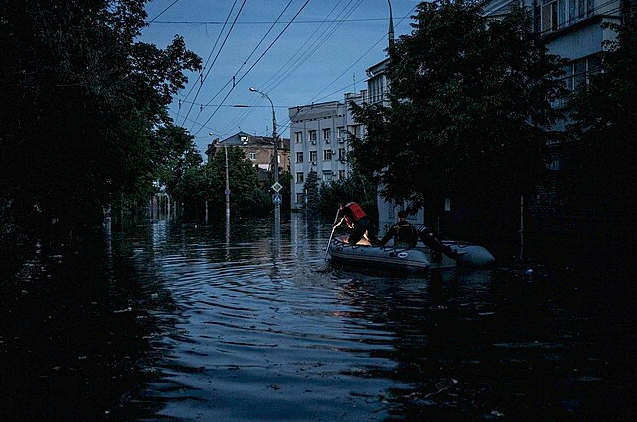Tens of Thousands at Risk Amid Southern Ukraine Floods
Following the collapse of the Nova Kakhovka dam in Ukraine's Kherson region on Tuesday, government officials from Ukraine and Russia said that tens of thousands of people are at risk as floods continued to sweep through communities on both sides of the Dnipro River on Wednesday.

Facts
- Following the collapse of the Nova Kakhovka dam in Ukraine's Kherson region on Tuesday, government officials from Ukraine and Russia said that tens of thousands of people are at risk as floods continued to sweep through communities on both sides of the Dnipro River on Wednesday.1
- Russian troops occupied the whole of the Kherson region at the outset of the war, but withdrew from positions on the western bank of the river in November. The river now serves as the dividing line between Russian and Ukrainian control over Kherson in Ukraine's south.2
- On the western bank, Ukrainian officials said 16K people lived in the most critically affected areas, adding that national guard teams and emergency crews were working to evacuate those that hadn't yet gotten out.1
- Meanwhile, Russia's appointed governor of the Kherson region, Vladimir Saldo, said 22-40K people were living in now flood-hit zones on the eastern bank. Saldo added seven people were reported missing at this stage. As things stand, there were no reports of flooding-related deaths on either side.3
- Oleksandr Tolokonnikov, a spokesman for Ukraine's military administration in Kherson, said that water levels are expected to rise another meter on Wednesday before they begin to fall. Flooding is nonetheless expected to persist for several more days before it subsides.4
- The long term damage is predicted to be substantial, with thousands of homes and businesses expected to be washed away. Flora and fauna may be wiped out for decades and explosive mines planted by both armies will be randomly distributed among the flood-hit towns. The local agriculture sector is also expected to suffer from water shortages, while drinking water is also expected to be in short supply.5
Sources: 1Associated Press, 2NBC, 3TASS, 4UKRINFORM, and 5Guardian.
Narratives
- Pro-Ukraine narrative, as provided by Ukrainska Pravda. In blowing up the Kakhovka dam, Russia has committed an egregious war crime as well as the largest man-made ecological disaster in Europe in decades. It must pay the price for this act of eco-terrorism.
- Pro-Russia narrative, as provided by TASS. What would Russia gain from cutting off the water supply to Crimea which it considers its territory? This is unequivocally an act of sabotage carried out by Ukraine, probably to distract from its already faltering counteroffensive.
- Narrative C, as provided by Atlantic. As much as this is a hot war between Russia and Ukraine, it's also an information war, with both sides disseminating vast amounts of propaganda for their own geopolitical objectives. It's easy to make snap judgments, but serious examination is needed before any conclusions can be reached — including exploring the possibility of a simple structural failure causing this tragic disaster.






